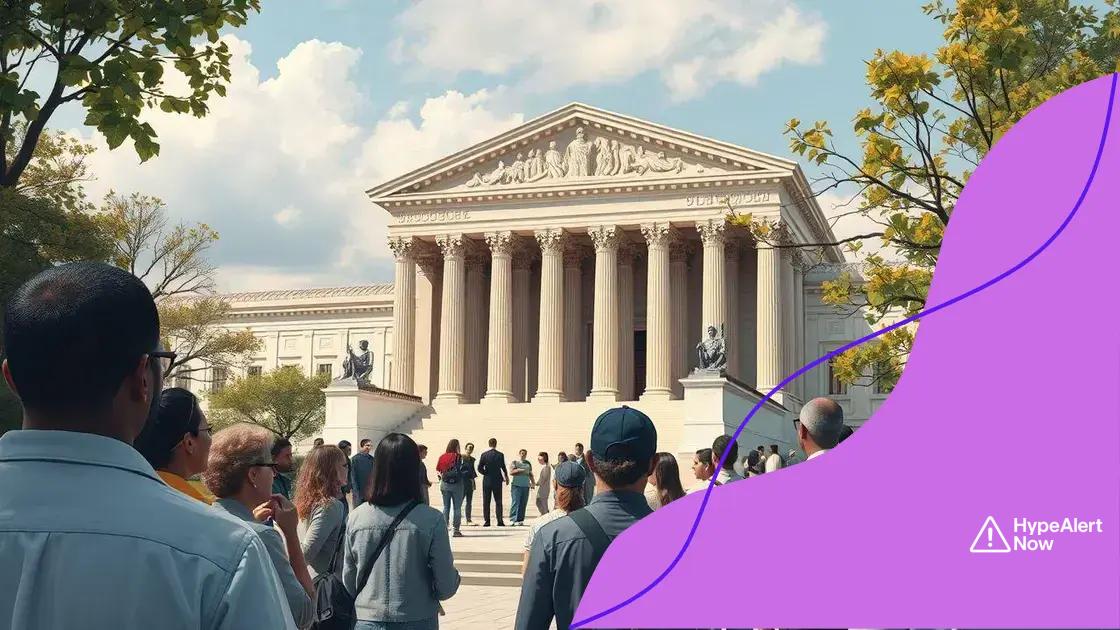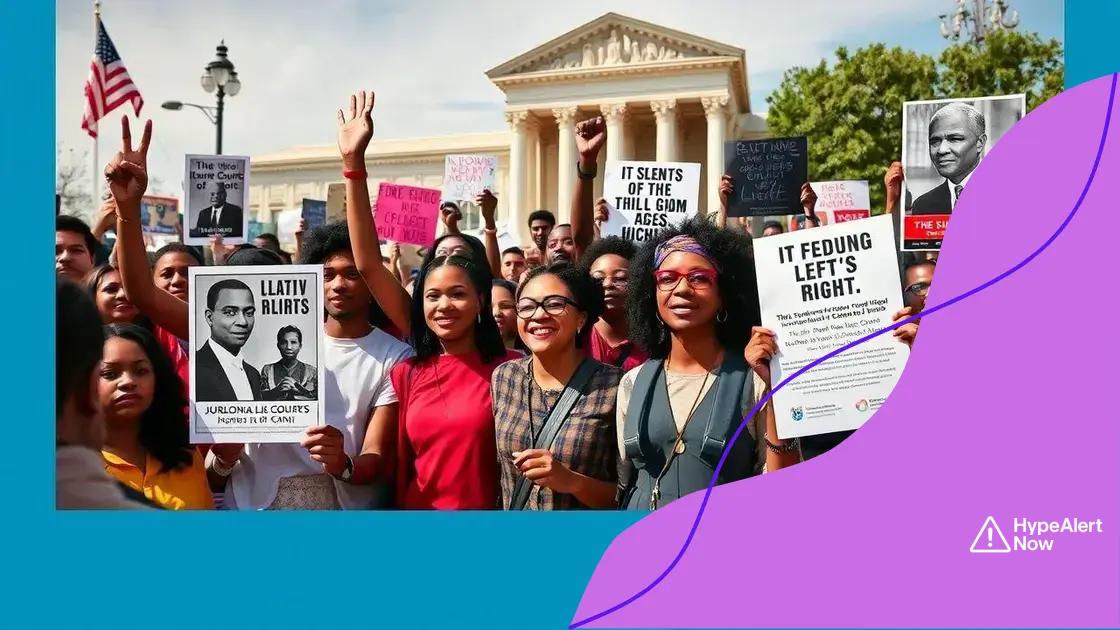Supreme Court decisions and their implications on society

Supreme Court decisions and their implications significantly affect civil rights, public sentiment, and future legal challenges, shaping justice and equality in American society.
Supreme Court decisions and their implications resonate throughout our society, influencing everything from individual rights to national policies. Have you ever wondered how these rulings shape our daily lives? Let’s delve into the intricacies of their effects.
Understanding the role of the Supreme Court
Understanding the role of the Supreme Court is crucial to grasping how our legal system functions. This pivotal institution interprets the Constitution and ensures justice is upheld across the United States. The decisions it makes impact various aspects of society, from individual rights to federal laws.
What is the Supreme Court?
The Supreme Court is the highest court in the United States. It has the authority to decide cases that involve federal law, including disputes between states and questions about constitutional rights. When individuals or groups believe their rights have been violated, they can appeal to this court, which has the final say in those matters.
Functions of the Supreme Court
The court has several key functions, including:
- Interpreting laws and their meanings.
- Settling disputes that involve federal law.
- Reviewing decisions made by lower courts.
- Protecting the rights and liberties of citizens.
The Supreme Court’s decisions can have lasting effects on civil rights and social issues. For example, landmark cases such as Brown v. Board of Education and Roe v. Wade have transformed American society. These rulings demonstrated the court’s power and its responsibility to safeguard individual freedoms.
Moreover, the composition of the Supreme Court can influence its rulings. Justices are nominated by the President and confirmed by the Senate, making the appointment process politically significant. This relationship often leads to debates about how the court interprets the Constitution based on the personal beliefs of the justices.
Public awareness of the Supreme Court’s role is essential, as it enables citizens to engage with important legal issues. Understanding the implications of the court’s decisions can lead to informed discussions and civic engagement.
In summary, knowing the role of the Supreme Court helps us see how laws evolve and how justice is served. We all have a stake in the outcomes of its decisions.
Key decisions that shaped American law
Throughout history, several key decisions have significantly shaped American law. These landmark rulings have influenced civil rights, social justice, and the interpretation of the Constitution. Understanding these decisions helps us appreciate how the legal system evolves.
Brown v. Board of Education
One of the most notable cases is Brown v. Board of Education (1954). This decision declared racial segregation in public schools unconstitutional. The Court unanimously ruled that “separate but equal” educational facilities were inherently unequal. This case was pivotal in the fight against racial discrimination and set the stage for the civil rights movement.
Roe v. Wade
Another significant ruling is Roe v. Wade (1973), which addressed a woman’s right to choose. The Supreme Court recognized the right to privacy under the Due Process Clause of the 14th Amendment. This decision allowed women to make their own reproductive choices, fundamentally altering the legal landscape regarding abortion rights.
Miranda v. Arizona
Miranda v. Arizona (1966) established important rights for criminal suspects. The Court ruled that individuals in police custody must be informed of their rights before being interrogated. This decision led to the creation of the “Miranda warning,” which protects the rights of the accused and ensures fair treatment under the law.
- These decisions highlight the role of the Supreme Court in shaping societal norms.
- They exemplify how legal interpretations can change over time.
- The impact of these rulings continues to resonate in contemporary legal discussions.
As we explore these landmark cases, it’s clear that the Supreme Court plays a vital role in defining justice and equality in America. Each decision reflects the values and beliefs of the society at the time, showcasing the dynamic relationship between law and social evolution.
Impacts of rulings on civil rights

The impacts of rulings on civil rights have been profound and far-reaching in American history. Decisions made by the Supreme Court have helped to establish and protect the rights of various groups, influencing the way society views equality and justice.
Key Civil Rights Cases
Several landmark cases illustrate how judicial rulings shape civil rights. For instance, the ruling in Loving v. Virginia (1967) invalidated laws against interracial marriage. This was a significant step toward racial equality and personal freedom, reinforcing the notion that love should not be limited by race.
The Role of the Court in Social Change
The Supreme Court often acts as a catalyst for social change. For example, the case of Obergefell v. Hodges (2015) legalized same-sex marriage across the country. This ruling acknowledged the rights of LGBTQ+ individuals and was seen as a major victory for civil rights advocates.
Additionally, decisions about voting rights continue to shape the democratic process. The Voting Rights Act of 1965 was a response to systemic discrimination, and while it faced challenges through rulings like Shelby County v. Holder (2013), the struggle for equitable access remains a significant aspect of civil rights discussions.
- Rulings often reflect the values of society at the time.
- Decisions can lead to new laws that protect civil liberties.
- The ongoing dialogue surrounding previously settled rights shows the fluid nature of law.
Understanding the impacts of these rulings highlights their importance in structuring a fair society. Each case represents a point of struggle, reflection, and progress for civil rights in America.
The relationship between Supreme Court and public opinion
The relationship between the Supreme Court and public opinion plays a crucial role in shaping legal interpretations and outcomes. While the Court is meant to be apolitical, its decisions often reflect the values and beliefs of society.
Influence of Public Sentiment
Public opinion can influence the Supreme Court in complex ways. For instance, when there is widespread support or opposition to certain issues, justices may feel compelled to consider these views in their rulings. Cases related to civil rights, social justice, and marriage equality often showcase this relationship.
Case Examples
In cases like Obergefell v. Hodges, the public’s growing acceptance of same-sex marriage influenced the Court’s decision to legalize it nationwide. Legal rulings can also push public opinion, as seen in cases addressing segregation and discrimination, which shaped societal attitudes towards equality.
On the other hand, the justices may sometimes act against prevailing public sentiment to uphold constitutional principles. For example, rulings concerning free speech or minority rights may not always align with popular opinion. This tension highlights the delicate balance the Court must maintain between adhering to the Constitution and reflecting societal values.
- The Supreme Court’s legitimacy often relies on public trust.
- Media coverage can amplify public reactions to court rulings.
- Public protests and advocacy can sway opinions about future cases.
Ultimately, the dynamics between the Supreme Court and public opinion underscore the importance of civic engagement. Awareness of this relationship helps citizens understand the broader implications of legal decisions on society.
Future challenges for the Supreme Court
The future challenges for the Supreme Court are shaped by changing societal norms and expectations. As new issues arise, the Court must navigate complex legal landscapes while upholding the Constitution.
Emerging Legal Issues
One of the significant challenges is addressing technology’s rapid advancement. Cases involving digital privacy, cybersecurity, and online free speech are becoming more prevalent. The justices must interpret laws that were not designed for today’s technological context. This can create friction as they attempt to balance individual rights and governmental interests.
Social Justice Movements
Additionally, movements advocating for racial equality, gender rights, and climate action will likely continue to pressure the Court. Cases that test the boundaries of civil rights and liberties are on the rise. Justices may face public scrutiny and demands for progressive interpretations of the law.
The polarization of American politics also presents a challenge. As the nation becomes more divided, partisan perspectives can influence the judicial process. Ensuring impartiality while considering public opinion is crucial for maintaining the legitimacy of the Court.
- Legal precedents are often challenged by societal changes.
- The Court’s decisions will shape the legislative landscape.
- Challenges in interpreting constitutional rights in modern contexts persist.
Understanding these future challenges is essential for anyone interested in American law and societal progress. Keeping a watchful eye on how the Supreme Court adapts to these issues will reveal much about the future of justice in America.
FAQ – Frequently Asked Questions about Supreme Court Decisions and Their Implications
How do Supreme Court decisions impact civil rights?
Supreme Court decisions can significantly shape civil rights by establishing legal precedents that protect or restrict individual freedoms.
What role does public opinion play in Supreme Court rulings?
Public opinion can influence the Court’s decisions, as justices are often aware of societal values and attitudes when making rulings.
What are some future challenges for the Supreme Court?
Future challenges include addressing emerging issues like technology, balancing social justice movements, and navigating political polarization.
How can citizens engage with the Supreme Court’s work?
Citizens can stay informed, participate in discussions, and advocate for issues that matter to them, influencing public opinion and potentially impacting future rulings.
